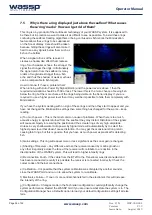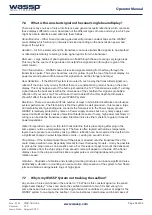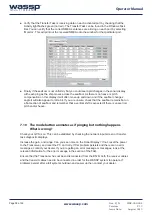
Doc. P/N:
WSP-009-004
Version:
V1.3
Issue Date:
August 2013
Page 56 of 62
Operator Manual
QRLVHLWPD\QRWEHSRVVLEOHWRDXWRPDWLFDOO\UHVXPHVHDÀRRUWUDFNLQJ
Power – If too much power is being used for the depth of water you are operating in, the
VHDÀRRUWUDFNLQJVLJQDOFRXOGEHQRLV\HVSHFLDOO\LIWKHUHLVHQRXJKSRZHUWRFDXVHVLJQDO
distortion, as the tracking algorithm may track the rings produced by this. Conversely, too low a
SRZHUOHYHOPD\UHVXOWLQWKHVLJQDOOHYHOVIURPWKHVHDÀRRUEHLQJEHORZWKHQRLVHÀRRURIWKH
system and thus they will be ignored as noise. This will tend to cause the surface noise to be
considered as a bottom detection candidate.
Depth
±7KH:$663V\VWHPFDQDFTXLUHDVHDÀRRUSUR¿OHVZDWKWLPHVWKHQDGLUGHSWK
but this requires the acquisition depth to be at least twice that of the maximum depth on that
swath. WASSP takes this into account so when the Depth Dial reads 100m, the system acquires
to 210m. If the acquisition depth is in manual mode or the system fails to track down with the
VHDÀRRUWKHQ\RXPD\QHHGWRPDQXDOO\LQFUHDVHWKHV\VWHPUDQJHWRDOORZLWWRUHDFTXLUHWKH
VHDÀRRU
GPS Position – If there is no position the WASSP system will not output depth data and will
FHDVHWRPDSWKHVHDÀRRU
Minimisation
±7KHVHDÀRRUWUDFNLQJLVDIIHFWHGE\WKH0LQLPLVDWLRQOHYHOHQVXUHWKLVLVVHW
appropriately as described in the Installation Manual.
7.8
Why doesn’t the sea
fl
oor line up when I go over it again?
There are several factors which can cause this to show on your WASSP display however
remember that if the vessel is operating in a high sea state, your motion sensor may not be able
to fully compensate for the vessel’s movement:
GPS Time Lag
±(QVXUHWKDWDQ\*36GHOD\LVHQWHUHGLQWRWKH6KLS6HWXS&RQ¿JXUDWLRQDVWKLV
Motion Compensation – To make good use of motion compensation we must ensure that the
WASSP transducer and any Motion sensors are securely mounted and do not move at all. The
dynamic and static accuracy of the motion sensor effectively determines the differences you can
expect when you pass over the same area again.
Sea State – Motion Compensation is a complex process and makes some assumptions – the
ELJJHUWKHVHDVWDWHDQGWKHVPDOOHUWKHERDWWKHOHVVUHOLDEOHWKHVHDÀRRUGDWDZLOOEHDVWKHUH
is more reliance on the accuracy of measurements and the input from the motion sensors.
Cornering – Motion compensation is costly to do to the nth degree. Most low end Motion
sensors have poor performance on corners due to the centripetal acceleration forces caused by
DWXUQDIIHFWLQJWKHGHOLFDWHEDODQFHRIWKHVHQVRU7KXVVHDÀRRUGHWHFWLRQVFROOHFWHGZKLOHWKH
boat is turning are likely to be of lesser quality than those collected in a straight line.
Water Temperature
– The water temperature and salinity affect the sound speed and thus the
DQJOHDWZKLFKWKHVRXQGPRYHVWKURXJKWKHZDWHUFROXPQ7KLVFDXVHVWKHVHDÀRRUWRFXUYH
XSRUGRZQDVQRWHGLQWKHRSHUDWRUPDQXDO,IWKHVHDÀRRUH[KLELWVDFXUYHXSRUGRZQRQWKH
HGJHVDGMXVWWKHVRXQGVSHHG1RWH7KHVXUIDFHZDWHUWHPSHUDWXUHZLOOSUREDEO\FKDQJH
during the course of a day.
Tide Correction – Tide is essential for matching up overlapping swaths. If you have disabled
the Tide correction the swaths will rarely line up on your WASSP displays. Ensure that the ZDA
sentence is being collected and sent to the WASSP computer so it can determine the UTC time
and use the correct tide correction value.
Transducer Offsets – The transducer, GPS and draft offsets need to be input into the WASSP
VKLSVHWXSFRQ¿JXUDWLRQVRWKDWWKHPRWLRQLQGXFHGHUURUVLQWKHVHDÀRRUFDQEHFRUUHFWO\
























